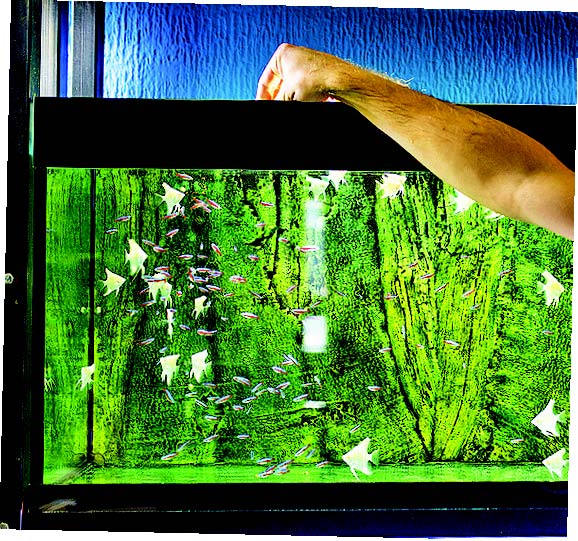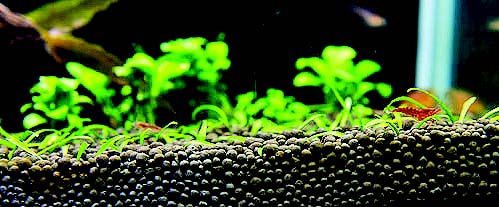I was four when I had my first aquarium. It was a small tank — a five-gallon tank, if I’m not mistaken. I had three black mollies, a dried coral for decoration, a few strands of water weed (Egeria densa) planted behind the coral, an air pump connected to an undergravel filter, and white sand that covered the bottom.
In the earlier years of Philippine fishkeeping, all our tanks had sand. All tanks were generally set up this way, because that was pretty much all the aquarium stuff we had in the fish shops.

Since the only filtration available at that time was the undergravel filter, sand was needed as it served as the medium of the biological filter system. In essence, sand was an integral part of the aquarium system and the decoration as well. Hence, we all set up our tanks with sand.
Having an undergravel filter was something fishkeepers bragged about at that time. Your tank would have been considered top of the line if you had this technology. Having one was such a convenience — it meant we had crystal-clear water in our aquariums and we could appreciate the fishes more. It was a game changer, giving us cleaner tanks. Water quality was better and the fish, healthier.
This also enabled us to take care of more fish in the tank.
While the undergravel filter did wonders for the aquarium, it was such a challenge to clean. With the concept of nitrogen cycle and partial water change still unavailable at the time, cleaning the tank meant practically dismantling it and setting it up again.
Thus, we had to put all the fish in another container. The tank was dismantled and the sand and decoration rinsed in running water. After cleaning everything, the tank was set up and the fish returned to their tank.

It was such a huge undertaking to clean one’s aquarium. It was also a very risky way of doing tank maintenance. Of course, we now know today that it was a terrible way of cleaning one’s tank. Not only was it difficult, but it also totally went against the principles of proper tank maintenance.
Improving filtration technology
As the fishkeeping hobby developed in the 1970s through the 1990s, improvements in technology introduced better filter systems: internal box, canister, overhead, trickle, etc. Filter media also improved: filter wool, sponge or foam, ceramic rings, and bio balls, to name some. These should sound familiar to you since these are the same filters and media used today and had their beginnings long ago.
The reliance on sand began to dwindle. Suddenly, it didn’t have to be in the aquarium and was beginning to become an unpopular option, what with tank maintenance becoming such a herculean effort with it. Slowly, Filipinos were foregoing sand, giving rise to the “bare tank” approach.
Nowadays, bare tanks are preferred to those with substrates. (However, let me use substrates since options today are no longer restricted to white beach sand of the 1970s.) I would say about 80 percent of Filipino fishkeepers would rather set up a bare tank. If you go to fish groups and forums, you often see this question: How do you clean aquarium sand or gravel?
Nowadays, cleaning the substrate is so easy, especially with the gravel cleaner. This, for me, is one of the greatest inventions in fishkeeping. Since it was introduced in the 1990s, I have been a big fan of the gravel cleaner and I always make sure I have one.
How do they do it?
While most prefer a bare tank, some are convinced that using a substrate is so much more aesthetically pleasing. While substrates can be burdensome, some don’t mind if it means a better-looking tank.
Good thing we no longer have to dismantle a tank to clean the substrate. Once a tank has been set up and completely cycled, only minimal maintenance in the form of partial water change is all that’s needed to keep a tank in optimal condition.

Substrate, whether sand or gravel, will collect dirt, leftover food, and all sorts of organic waste. These accumulate and water quality soon deteriorates. Cleaning the substrate is then necessary but since the inception of the bare tanks, many Filipinos have forgotten how to do it.
Cleaning made simple
The gravel cleaner is a simple gadget. It is merely a hose with a nozzle on one end, a plastic tube whose diameter is at least twice that of the hose. It is used like a regular siphon, with the nozzle jammed into the substrate. The grains of sand or gravel will then spin and tumble as water is siphoned off. Since the grains are heavy, only the dirt is sucked out with the water to the other end of the gravel cleaner. The sand or gravel fall back to the bed, clean and devoid of organic waste.
After about 30 percent of the water has been siphoned, the tank is refilled with fresh water. There’s no need to do the entire substrate bed; one can continue next week.
Weekly substrate cleaning will eventually achieve a completely clean tank in few weeks. The important thing is partially deloading the tank of gunk.
The key is the big diameter of the nozzle, which has a siphoning force less than that of the hose. The substrate merely tumbles and spins while being sucked. If it was just the hose, it would have picked up the substrate.
The gravel cleaner is a simple tool that should be available in most fish stores at a reasonable price. If not, you can construct one yourself. With a gravel cleaner on hand, there is no need to worry about cleaning substrate.
Substrate being siphoned out?
One of the biggest frustrations when cleaning substrate is accidentally picking up substrate with the gravel cleaner. Of course, you would like to save as much substrate you can.
The gravel cleaner was designed to pick up the dirt but leave the substrate in the tank. Sometimes, however, substrate is accidentally picked up as well for the following reasons.
• The substrate is too light
• The height of the tank is high and the other end of the gravel cleaner is very low. This increases the velocity of the siphon effect.
• The velocity of the siphon is just too fast.
To slow down the siphon, you may plug the other end with your thumb or control the flow by pinching or folding the hose. Elevating the other end of the gravel cleaner may also work.
This appeared in Animal Scene magazine’s January 2019 issue.





